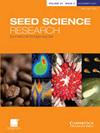更多关于种子寿命表型
IF 1.9
3区 生物学
Q2 PLANT SCIENCES
引用次数: 5
摘要
了解不同种子批次(可能是不同物种或基因型)的相对寿命,以及在不同环境、不同栽培方法或不同采后处理下生产后的相对寿命,对于任何关心种子批次在储存期间活力和活力保持的人都是有意义的。然而,多年来,不同的科学家使用不同的条件来评估种子的寿命,以及不同的变量作为“寿命”的衡量标准。在这里,我们给出了两个标准方案的一些背景,分别是开放和封闭系统,是如何衍生的,并解释了为什么我们认为p50是一个合适的长寿性状参数,p50定义为通过发芽试验测量的种子批次活力下降到50%的储存时间。本文章由计算机程序翻译,如有差异,请以英文原文为准。
More on seed longevity phenotyping
Abstract Understanding the relative longevity of different seed lots, perhaps of different species or genotypes, but also following production under different environments or using different cultivation methods, or following different post-harvest treatments, is relevant to anyone concerned with the retention of seed lot viability and vigour during storage. However, different scientists over the years have used different conditions to assess seed lot longevity, as well as different variables as the measure of ‘longevity.’ Here, we give some of the backgrounds to how two standard protocols, with an open and closed system respectively, were derived, and explain why we consider p50, defined as the time during storage when seed lot viability, as measured through a germination test, has declined to 50%, is a suitable longevity trait parameter.
求助全文
通过发布文献求助,成功后即可免费获取论文全文。
去求助
来源期刊

Seed Science Research
生物-植物科学
CiteScore
3.60
自引率
4.80%
发文量
23
审稿时长
>12 weeks
期刊介绍:
Seed Science Research, the official journal of the International Society for Seed Science, is a leading international journal featuring high-quality original papers and review articles on the fundamental aspects of seed science, reviewed by internationally distinguished editors. The emphasis is on the physiology, biochemistry, molecular biology and ecology of seeds.
 求助内容:
求助内容: 应助结果提醒方式:
应助结果提醒方式:


